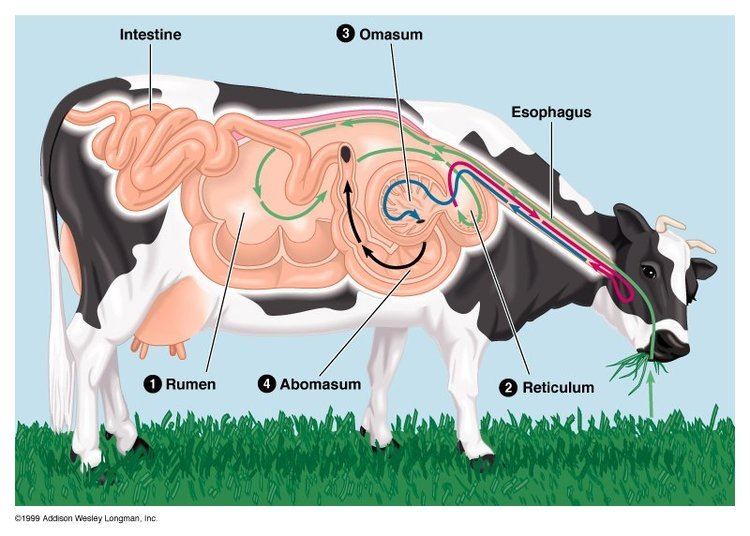 | ||
Gestation period Cattle: 283 days, Sheep: 152 days Height Goat: 41 – 58 cm, Giraffe: 5 – 6 m, Reindeer: 85 – 150 cm Lifespan Cattle: 18 – 22 years, Sheep: 10 – 12 years, Goat: 15 – 18 years, Moose: 15 – 25 years, Elk: 10 – 13 years Mass Cattle: 1,100 kg, Sheep: 45 – 160 kg, Goat: 20 – 140 kg Length Sheep: 1.3 m, Giraffe: 4.2 m, Reindeer: 1.8 – 2.1 m Speed Giraffe: 60 km/h, Reindeer: 60 – 80 km/h Representative species Cattle, Sheep, Goat, Reindeer, Moose | ||
Ruminants are mammals that are able to acquire nutrients from plant-based food by fermenting it in a specialized stomach prior to digestion, principally through microbial actions. The process typically requires the fermented ingesta (known as cud) to be regurgitated and chewed again. The process of rechewing the cud to further break down plant matter and stimulate digestion is called rumination. The word "ruminant" comes from the Latin ruminare, which means "to chew over again".
Contents
- Digestive physiology of the ruminant
- Description
- Classification and taxonomy
- Abundance distribution and domestication
- Ruminant physiology
- Rumen microbiology
- Tannin toxicity in ruminant animals
- Religious importance
- Other uses
- Ruminants and climate change
- References
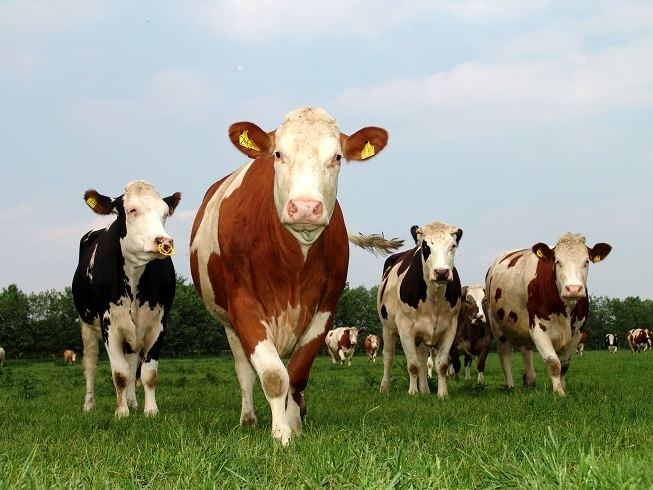
The roughly 150 species of ruminants includes both domestic and wild species. Ruminating mammals include cattle, goats, sheep, giraffes, yaks, deer, antelope, and some macropods. It has also been suggested that notoungulates also relied on rumination, as opposed to other antlantogenates that relied on the more typical hindgut fermentation, though this is not entirely certain.
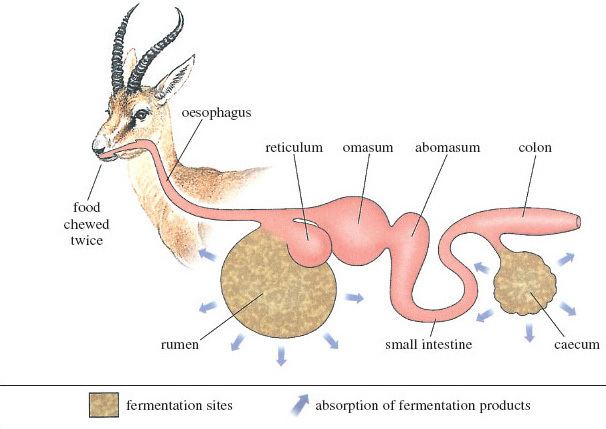
Taxonomically, the suborder Ruminantia (also known as ruminants) is a lineage of herbivorous artiodactyls that includes the most advanced and widespread of the world's ungulates. The term 'ruminant' is not synonymous with Ruminantia. The suborder Ruminantia includes many ruminant species, but does not include tylopods and marsupials.
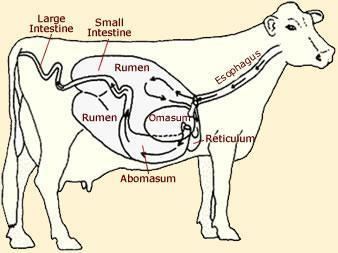
Digestive physiology of the ruminant
Description

The primary difference between a ruminant and nonruminant is that ruminants have a four-compartment stomach. The four parts are the rumen, reticulum, omasum, and abomasum. In the first two chambers, the rumen and the reticulum, the food is mixed with saliva and separates into layers of solid and liquid material. Solids clump together to form the cud or bolus.
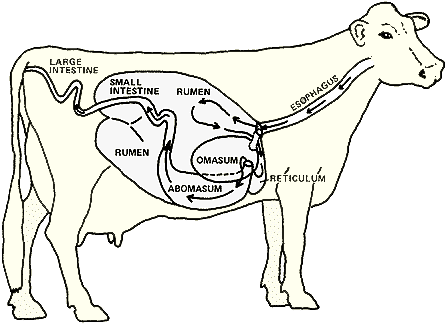
The cud is then regurgitated and chewed to completely mix it with saliva and to break down the particle size. Fiber, especially cellulose and hemicellulose, is primarily broken down in these chambers by microbes (mostly bacteria, as well as some protozoa, fungi and yeast) into the three volatile fatty acids (VFAs): acetic acid, propionic acid, and butyric acid. Protein and nonstructural carbohydrate (pectin, sugars, and starches) are also fermented.
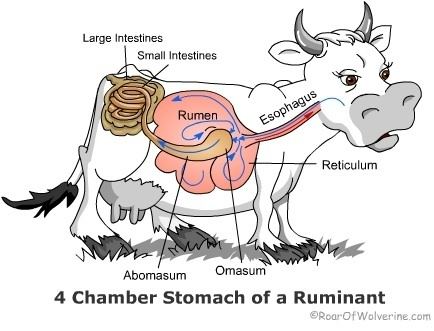
Though the rumen and reticulum have different names, they represent the same functional space as digesta can move back and forth between them. Together, these chambers are called the reticulorumen. The degraded digesta, which is now in the lower liquid part of the reticulorumen, then passes into the next chamber, the omasum, where water and many of the inorganic mineral elements are absorbed into the blood stream.
After this, the digesta is moved to the true stomach, the abomasum. The abomasum is the direct equivalent of the monogastric stomach, and digesta is digested here in much the same way. Digesta is finally moved into the small intestine, where the digestion and absorption of nutrients occurs. Microbes produced in the reticulorumen are also digested in the small intestine. Fermentation continues in the large intestine in the same way as in the reticulorumen.
Only small amounts of glucose are absorbed from dietary carbohydrates. Most dietary carbohydrates are fermented into VFAs in the rumen. The glucose needed as energy for the brain and for lactose and milk fat in milk production, as well as other uses, comes from nonsugar sources, such as the VFA propionate, glycerol, lactate, and protein. The VFA propionate is used for around 70% of the glucose and glycogen produced and protein for another 20% (50% under starvation conditions).
Classification and taxonomy
Hofmann and Stewart divided ruminants into three major categories based on their feed type and feeding habits: concentrate selectors, intermediate types, and grass/roughage eaters, with the assumption that feeding habits in ruminants cause morphological differences in their digestive systems, including salivary glands, rumen size, and rumen papillae.
Also, some mammals are pseudoruminants, which have a three-compartment stomach instead of four like ruminants. The Hippopotamidae (comprising hippopotami) are well-known examples. Pseudoruminants, like traditional ruminants, are foregut fermentors and most ruminate or chew cud. However, their anatomy and method of digestion differs significantly from that of a four-chambered ruminant.
Monogastric herbivores, such as rhinoceroses, horses, and rabbits, are not ruminants, as they have a simple single-chambered stomach. These hindgut fermenters digest cellulose in an enlarged cecum through the reingestion of the cecotrope.
Abundance, distribution, and domestication
Wild ruminants number at least 75 million and are native to all continents except Antarctica. Nearly 90% of all species are found in Eurasia and Africa. Species inhabit a wide range of climates (from tropic to arctic) and habitats (from open plains to forests).
The population of domestic ruminants is greater than 3.5 billion, with cattle, sheep, and goats accounting for about 95% of the total population. Goats were domesticated in the Near East circa 8000 BC. Most other species were domesticated by 2500 BC., either in the Near East or southern Asia.
Ruminant physiology
Ruminating animals have various physiological features that enable them to survive in nature. One feature of ruminants is their continuously growing teeth. During grazing, the silica content in forage causes abrasion of the teeth. This abrasion is compensated for by continuous tooth growth throughout the ruminant's life, as opposed to humans or other nonruminants, whose teeth stop growing after a particular age. Most ruminants do not have upper incisors; instead, they have a thick dental pad to thoroughly chew plant-based food.
Rumen microbiology
Vertebrates lack the ability to hydrolyse the beta [1-4] glycosidic bond of plant cellulose due to the lack of the enzyme cellulase. Thus, ruminants must completely depend on the microbial flora, present in the rumen or hindgut, to digest cellulose. Digestion of food in the rumen is primarily carried out by the rumen microflora, which contains dense populations of several species of bacteria, protozoa, sometimes yeasts and other fungi - 1 ml of rumen is estimated to contain 10-50 billion bacteria and 1 million protozoa, as well as several yeasts and fungi.
Since the environment inside a rumen is anaerobic, most of these microbial species are obligate or facultative anaerobes that can decompose complex plant material, such as cellulose, hemicellulose, starch, and proteins. The hydrolysis of cellulose results in sugars, which are further fermented to acetate, lactate, propionate, butyrate, carbon dioxide, and methane.
As bacteria conduct fermentation in the rumen, they consume about 10% of the carbon, 60% of the phosphorus, and 80% of the nitrogen that the ruminant ingests. To reclaim these nutrients, the ruminant then digests the bacteria in the abomasum. The enzyme lysozyme has adapted to facilitate digestion of bacteria in the ruminant abomasum. Pancreatic ribonuclease also degrades bacterial RNA in the ruminant small intestine as a source of nitrogen.
During grazing, ruminants produce large amounts of saliva - estimates range from 100 to 150 litres of saliva per day for a cow. The role of saliva is to provide ample fluid for rumen fermentation and to act as a buffering agent. Rumen fermentation produces large amounts of organic acids, thus maintaining the appropriate pH of rumen fluids is a critical factor in rumen fermentation. After digesta pass through the rumen, the omasum absorbs excess fluid so that digestive enzymes and acid in the abomasum are not diluted.
Tannin toxicity in ruminant animals
Tannins are phenolic compounds that are commonly found in plants. Found in the leaf, bud, seed, root, and stem tissues, tannins are widely distributed in many different species of plants. Tannins are separated into two classes: hydrolysable tannins and condensed tannins. Depending on their concentration and nature, either class can have adverse or beneficial effects. Tannins can be beneficial, having been shown to increase milk production, wool growth, ovulation rate, and lambing percentage, as well as reducing bloat risk and reducing internal parasite burdens.
Tannins can be toxic to ruminants, in that they precipitate proteins, making them unavailable for digestion, and they inhibit the absorption of nutrients by reducing the populations of proteolytic rumen bacteria. Very high levels of tannin intake can produce toxicity that can even cause death. Animals that normally consume tannin-rich plants can develop defensive mechanisms against tannins, such as the strategic deployment of lipids and extracellular polysaccharides that have a high affinity to binding to tannins. Some ruminants (goats, deer, elk, moose) are able to consume feed high in tannins (leaves, twigs, bark) due to the presence in their saliva of tannin-binding proteins.
Religious importance
The Law of Moses in the Bible only allowed the eating of mammals that had cloven hooves (i.e. members of the order Artiodactyla) and "that chew the cud", a stipulation preserved to this day in Jewish dietary laws.
Other uses
The verb 'to ruminate' has been extended metaphorically to mean to ponder thoughtfully or to meditate on some topic. Similarly, ideas may be 'chewed on' or 'digested'. 'Chew the (one's) cud' is to reflect or meditate. In psychology, "rumination" refers to a pattern of thinking, and is unrelated to digestive physiology.
Ruminants and climate change
Methane is produced by the archea, methanogens, described above within the rumen, and this methane is released to the atmosphere. The rumen is the major site of methane production in ruminants. Methane is a strong greenhouse gas with a global warming potential of 86 compared to CO2 over a 20-year period.
In 2010, enteric fermentation accounted for 43% of the total greenhouse gas emissions from all agricultural activity in the world. The meat from ruminants has a higher carbon equivalent footprint than other meats or vegetarian sources of protein based on a global meta-analysis of lifecycle assessment studies. Methane production by animals, principally ruminants, is estimated 15-20% global production of methane.
